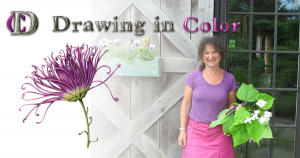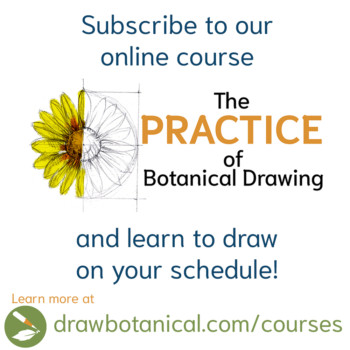I want to help you get started with botanical drawing. I will share with you the most common reasons that stop people from starting to draw, and I’ll give you tips on how to overcome these road blocks.
Often people think that accomplished artists are born with a natural talent to draw. I am here to tell you that if you have the desire to learn how to draw, and you commit to the time it takes, I can show you how.
What stops people from drawing?
Perfectionists often fear mistakes and are very critical of every mark they make. They think they will ruin their paper so instead of drawing they simply find reasons not to get started. Some people have a fear of a blank piece of paper and don’t know how or where to begin. Others start with a large set of colored pencils and can’t find the basic colors needed to get started. I am going to help you overcome this hurdle so your drawing experience is joyful and beneficial, and your drawing practice is infused with a newfound freedom.
Methods
I’ve been teaching botanical drawing for over 15 years, and I find the following techniques successful for getting started.
- The use of a step-by-step approach allows you to build on basic skills one at a time. Continue to practice one skill until you’ve mastered it, and then move on to the next.
- By practicing one technique at a time with only the goal of relaxing and slowing down you can avoid worrying about what your drawing looks like.
- It is important to feel comfortable with your materials right from the start and learn all their characteristics and nuances. I recommend a simple set of materials.
- Some of the first skills to practice are basic toning with one consistent light source and building layers upon layers of colored pencil. You will be amazed how pleasurable the act of building layers of tone and color feels. Drawing with a consistent light source gives you a clear understanding of where your shadows and highlights belong.
- Once you are comfortable with toning and light source, work on creating three-dimensional form on a natural specimen. I always recommend using a real subject from nature and avoid copying a photograph or someone else’s drawing.
- When you begin to draw from nature, you will inevitably be faced with the challenge of perspective. Perspective is a complex subject and is best studied by first learning to translate round forms into ellipses. A good first subject to practice is a daisy. Measuring correctly on an imaginary picture plane allows you to translate the three-dimensional world to a two-dimensional surface. Learn more about perspective here.
- Most importantly, allow nature’s beauty to guide you in combination with these basic techniques to avoid that overwhelming feeling of not knowing what to do next. By closely observing and then drawing what you see, you will learn about a plant’s structure as you draw.
Get Started!
- Schedule yourself a 30-minute time slot. Find 30 minutes to have quiet time to draw.
- Purchase a few materials, just enough colored pencils and a small pad of paper to begin.
- (I do recommend splurging on a really good pencil sharpener. You’ll need a very sharp pencil to render sharp details and saturate color.)
- Start small and begin with these 5 warm-up exercises to stretch your drawing muscles.
- Next, practice one simple subject such as a small branch or a small nut or fruit.
- Practice toning slowly and carefully and begin to layer color on top of form rendered with light and shadow in neutral tones.
- Consider our Botanical Basics program: short 30-minute lessons to help you get started. You will be amazed how you can develop an understanding of basic drawing skills in a brief amount of time.
- As you continue to develop your drawing practice you’ll enjoy a relaxed feeling, like meditation. Most of all, just GET STARTED and ENJOY the process of drawing slowly and connecting with nature by studying it close-up.


